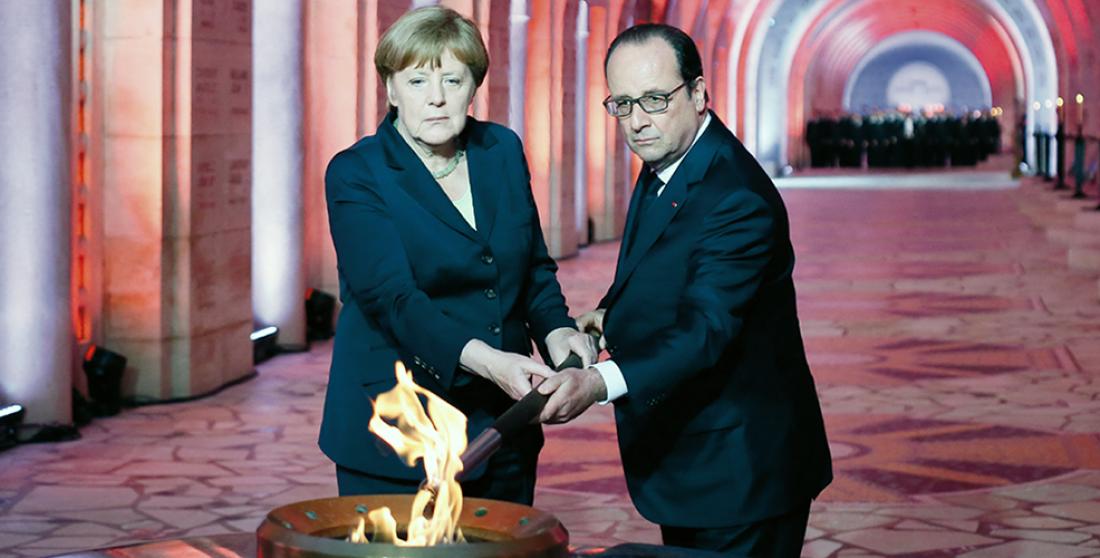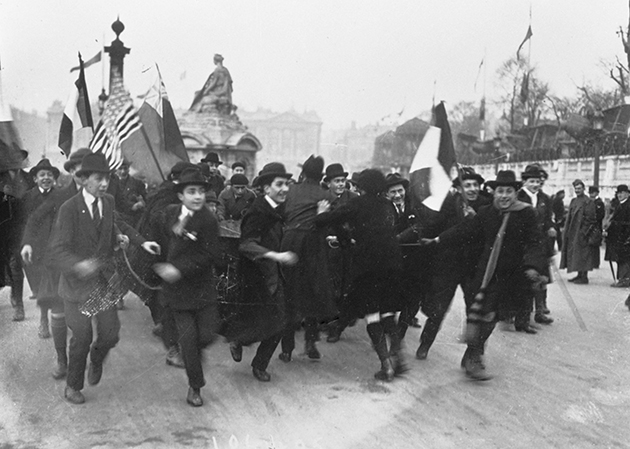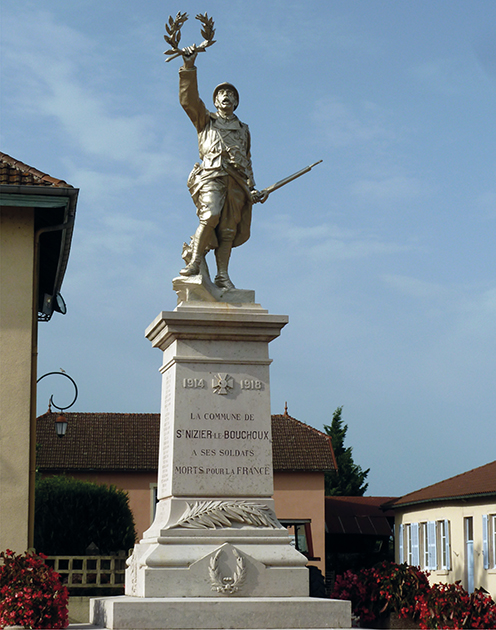Remembrance of the Great War

In France and Germany, the First World War centenary revived the memory of a conflict that left deep scars on the societies and landscapes of the two countries following the Armistice. In reality, that memory has never stopped permeating French and German soil. It has been constructed and reconstructed over the course of more than a century, in the light of national histories and European integration.
While the First World War remains “the Great War” to French people, in Germany it lost that title with the catastrophe of the Second. The explanation is simple: the Second World War affected Germany right to the core. Its towns and cities were buried under rubble, and millions of people, both civilians and soldiers, lost their lives. In France, despite the trauma of occupation and collaboration, the Second World War had a far lesser impact. France lost 220 000 soldiers and 330 000 civilians; Germany lost 5.5 million soldiers and far in excess of three million civilians.
German remembrance of the Great War, or the “war of the monuments”
In Germany, interest in the First World War remained negligible throughout the 1950s. The destruction of the cities, the immeasurable losses of soldiers and civilians, not to mention the crimes against humanity committed by the Nazis, had completely overshadowed the First World War. German Werth’s notable book about the Battle of Verdun, based on interviews with surviving Verdun veterans, was unable to find a serious publisher in Germany in the early 1970s and ended up being brought out by a publishing house specialising mainly in the stories of First World War German soldiers, or Landser.
The German memory was and has remained profoundly affected by the fact that the “legacy” of the Great War was eminently contentious. Why did we lose the war and why were we forced to sign the “shameful peace of Versailles”? That is why no official commemoration could be held and nothing could be done to silence the political quarrels over the graves of the soldiers who had died for their country. In addition to this fundamental polarity was the fact that the Weimar Republic was a federal State, and its federated states were entirely free to adopt their own rules, at times contradicting one another.
The memorials were all marked by a blunted heroism, often tinged with Christianity, in which the defeat was repressed or even transformed into victory. Still more important was the assertion that the fallen soldiers were “undefeated on the battlefield”. In all political camps, there was a need to give meaning to the soldiers’ deaths, and the issue of memorials permeated political debates and quarrels.
The memorial to the 39th Regiment, Reeser Platz, Düsseldorf, 2009. © Rights reserved
A good illustration of these tensions was the dispute triggered by the “Memorial to the 39th”, in Düsseldorf. The 39th Infantry Regiment (Lower Rhine) was of particular importance because it was Ludendorff’s own. Düsseldorf City Council opted for a large-scale “wounded warrior”-type monument, which was erected near the concert hall (Tonhalle). It portrayed two soldiers crawling on the ground, one holding his wounded comrade by the hand. Yet nationalists on all sides considered the sculpture – which was highly realistic and not particularly critical of the war – to be “unworthy”. It was all the more unacceptable to them since the two men looked “foreign” somehow, “Semitic” even, as its opponents lamented at the time. The memorial was regularly damaged and defaced – and in 1933, as soon as the Nazis came to power, it was replaced by the “heroic” monument that stands to this day on Reeser Platz.
The political situation in Germany was so strained that the planned erection of memorials was prevented from taking place in a great many localities. The examples cited by Lurz on the subject are legion. The case of Marbach am Neckar, Schiller’s birthplace, is particularly interesting. Near the old town gate, there still stands today one of the strangest First World War memorials. Two soldiers – one from the First World War, the other a soldier of the Wehrmacht, recognisable by their helmets – are clothed in a single Wehrmacht uniform. The monument was the product of over ten years of controversy. For here, as in many other places across Germany, the “war of the monuments” ended in March 1933, when “heroic” memorials began being erected across the country. Another example is the gigantic monument in the town of Bochum. Here, a soldier of the Wehrmacht holds a sword with the help of a soldier of the First World War. The same goes for the Düsseldorf memorial to the 39th Infantry Regiment. Unveiled in 1936, it shows a group of First World War soldiers descending into the tomb, as a group of soldiers of the new Wehrmacht comes rising up out of it. Engraved upon it are the names of First and Second World War battles.
The Marbach am Neckar memorial, September 2019. © Rights reserved
Thus it was the advent of National Socialism that standardised First World War remembrance culture in Germany. The National Socialists had been firmly committed to this remembrance struggle since the 1920s. In his election campaigns from 1925 onwards, Adolf Hitler continually emphasised his victim status and called for all victims of 1914-18 to be remembered. This won him the support of huge numbers of voters among First World War veterans and their families. The National Socialists had put First World War remembrance and the honours due to its heroes right at the heart of their political agenda. Undoubtedly the most interesting example is the monumental arch planned by Hitler, sketched in his own hand in 1925 and for which construction work got underway even before 1940. The arch was to be at the centre of Berlin’s transformation into “Germania”. The idea was for it to be engraved with the names of all the German soldiers killed in the First World War, i.e. some two million names – clearly based on the British Thiepval Memorial in the Somme, which bears the names of more than 72 000 British soldiers.
French remembrance of the Great War, or the institutionalisation of remembrance
In France, by contrast, the war – won, albeit at great cost – aroused a shared memory of the suffering and heroism of soldiers and nation. Local councils, representing the Republic’s “institutionalised” grief, built a shared remembrance of the Great War, which not even the liveliest of controversies over domestic policy were able to break.

High-school students express their joy, Place de la Concorde, Paris, 11 November 1918. © Maurice-Louis Branger/Roger-Viollet
A law passed on 25 October 1919 decreed that every French commune must erect a war memorial. That law remains in force to this day, and there is indeed not a single commune that does not celebrate its poilus. Over 95% of French communes have a war memorial, whether it is right next to the mairie (town hall) and the school (in the case of communes of a left-wing republican persuasion), or near the church, in the case of communes with a more conservative, Catholic tradition.
All these memorials were commissioned practically “by catalogue”: communes could choose between a soldier thrusting forwards brandishing a flag, a soldier in his death throes, or a weeping mother holding her dead son to her bosom (a Pietà design); that was all the choice they had. Yet more often than not, it stood on a simple commemorative column bearing the inscription, “From the commune of XXX, to its children who died for France”, followed by the names of the soldiers killed on the battlefield. One can still appreciate today the incredible death toll suffered by France in the First World War – for instance, in a commune of 800 inhabitants where there are as many as 80 names, often including several sons from the same family.
As well as these statues with a fairly neutral design, which above all preserved the inner peace of the site, there are also rare cases of nationalistic or jingoistic representations, such as the triumphant poilu holding aloft a laurel wreath, or the poilu trampling a spiked helmet underfoot. More common is a depiction that undoubtedly reflects more faithfully the French conscience, in which the soldier’s stance symbolises the famous slogan of the Battle of Verdun in 1916: “They shall not pass.”

The war memorial of Saint-Nizier-le-Bouchoux (Ain), depicting a victorious soldier, 20 August 2021. © Rights reserved
Most important of all, however – and the main reason why these memorials have remained standing to this day (where they were not melted down during the German occupation of 1940-44, that is) – is that a consensus concerning them was reached from the outset. The planning and funding of the war memorials in France were neither wholly down to the communes, nor wholly the responsibility of the State. The aforementioned law of 1919 provided for State grants proportional to the financial outlay of the commune. The State contributed up to 15% of the costs of construction, and the level of its contribution was also conditioned to the choice of designs on offer in the catalogue.
Locally, the law of 1919 gave the responsibility for organising the ceremonies not to the State’s own institutions, but to the various veterans’ associations – primarily the powerful Union Nationale des Combattants, still active today. It also sought to prevent the commemorations from becoming an occasion for military displays. That is why 11 November and the local commemorations continue to be civilian rather than military today, and a time devoted not to glory but to grief, in memory of the French soldiers killed in action.
Unlike Germany, in France there was never much of a conflict around grief, since all French people – with a few rare exceptions – believed their country had fought a purely defensive war. That explains why there has never been a “war of the monuments”, although there have of course been local disagreements over the kind of monument that should be chosen. There has always been one certainty, which remains unwavering to this day: in the First World War, the poilus together defended “the sacred soil of the motherland” (in the words of the Marseillaise) against the German invader. That is also the reason why battles like those of the Marne and Verdun have remained firmly rooted in the French people’s collective memory.
Armistice Day over time: the history of a French remembrance
In France, 11 November was made an official day of commemoration and a public holiday by the law of 24 October 1922. This national day, which took the form of a military parade and a ceremony at the Arc de Triomphe in Paris, has remained institutionalised right up until today. On the day of the announcement of the official ceasefire, on 11 November 1918, people spontaneously converged on this place to express their joy. A year later, the first official event was held, at which the war-wounded were given centre stage. It is important to note that, despite all the military parades, the day went off without a hint of triumphalism. As Antoine Prost has shown, veterans’ associations have endeavoured to ensure that these commemorative events are always in memory of the comrades killed on the battlefield, and are not converted into victory celebrations.
The ceremony of 11 November 1968, presided over by head of State General de Gaulle. © Jacques Boissay/akg-images
This is best illustrated by the burial of the body of an unknown soldier (killed at Verdun) beneath the Arc de Triomphe, on 11 November 1920. A year later, the eternal flame was lit above the tomb by war minister André Maginot. Since then, it has been relit every day at 6.30 pm by representatives of the veterans. The meaning given to the Armistice Day ceremony has naturally changed over time. In 1938, for instance, when there was a particular emphasis on national unity in the face of the looming threat of war, delegations of veterans from all over France took part in marches and gathered at the Arc de Triomphe to light the flaming torches they had carried with them. In 1940, the Arc de Triomphe was the meeting point for a large-scale demonstration against the German occupier. In 1944, after the liberation of Paris, when General de Gaulle presided over the parade in the company of Winston Churchill, the prevailing mood was different from that of 1920. People wanted to express their joy and pride at being liberated from Nazism. In 1968, 11 November not only marked the 50th anniversary of the end of the First World War, it also served as a national rally against the student movement, which had deeply divided French society at the time. In 2018, President Macron had the idea of internationalising the ceremony to some extent. He invited all the heads of State and government of the nations that took part in the First World War to lay wreaths and relight the Eternal Flame at the Arc de Triomphe. It was a grand spectacle, which could have had an even more powerful symbolism if, for example, the American president, the British prime minister and the German chancellor had joined together as one with the French president to relight the Flame of Remembrance.
Towards a European remembrance of the Great War
There have also been promising initiatives for the future development of a shared remembrance of the war. The story of Douaumont Ossuary is a characteristic example. Construction of the ossuary began in 1920 on the initiative of the Bishop of Verdun, and it was largely paid for out of donations from French communes. Opened to the public in 1927, it was inaugurated with great pomp in 1932. Not content with being a focal point of French remembrance, the site also became a setting for international expressions of peace. Namely in 1936, when 10 000 French and German Verdun veterans gathered here to swear an oath that all those who had lived through Verdun would forever more champion peace among nations. Sadly, this proved to be an illusion, as this oath of peace was later shattered by Hitler’s war of aggression. However, 50 years later, in 1984, François Mitterrand and Helmut Kohl stood before the ossuary holding hands as they contemplated the memory of the victims, in an unforgettable gesture. It was already known that half the remains of the 140 000 unknown soldiers buried here were those of German soldiers, yet practically no one dared remember this in public. That omission was corrected in 2016, when, in a moving ceremony, Angela Merkel and François Hollande unveiled a huge inscription in the domed porch of the ossuary, so that this shared memory is now etched in stone: “Here lie French and German soldiers. Lest we forget.”
François Hollande and Angela Merkel relight the Flame of Remembrance at Douaumont Ossuary, on the centenary of the Battle of Verdun, 29 May 2016. © Mathieu Cugnot/Pool/AFP
This raises the question of whether, in the context of First World War remembrance, it might be possible to overcome national boundaries and reach a shared European remembrance, making it a cornerstone of European unity. I do not believe an entirely shared remembrance is possible. The different nations’ experiences of the First World War were far too varied, and the long periods of remembrance and reflection, as well as of amnesia, have historically been far too significant.
But it is possible and desirable for us in Europe to take up the remembrance traditions of our European neighbours and acknowledge them as being an integral part of our shared history. A wonderful example of this approach is the commemorative monument erected by the Nord-Pas-de-Calais region, on land donated to the Region by the State, opposite the National Cemetery of Notre Dame de Lorette: the Ring of Remembrance, which bears the names of the 580 000 soldiers killed in Artois from all participating nations. Here, symbolically, only the memory of the dead is commemorated. Faced with this sea of names, with no explicit mottoes or slogans, the visitor understands what lesson is to be learned: such a catastrophe must never be repeated.
Another pioneering example of the development of an internationalised remembrance of the First World War is the Historial Franco-Allemand de la Grande Guerre, on the Hartmannswillerkopf (Vieil Armand), which was officially opened in 2017 by presidents Emmanuel Macron and Frank-Walter Steinmeier, the first stone having been laid in 2014 by the French and German heads of State, François Hollande and Joachim Gauck. On this summit in the mountains of Alsace, the war had been a one-on-one confrontation between French and German troops, each defending this hotly disputed place. The site was therefore destined to become a key symbol of Franco-German friendship in the context of European cohesion.

